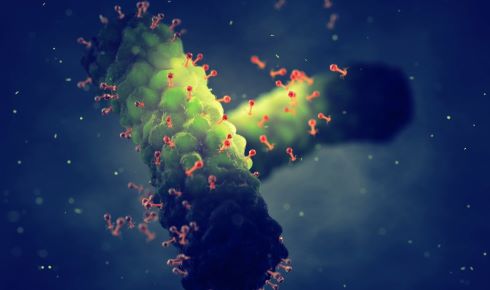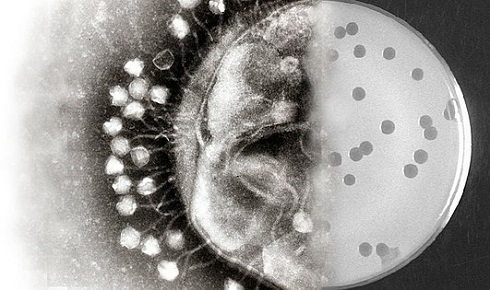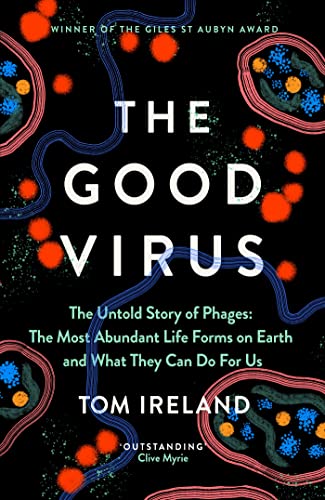Invisible allies

September 11th 2023
As the crisis of antibiotic resistance grows more acute, a new book explores whether it’s time to look to the past for solutions
The Biologist’s editor, Tom Ireland, recently released his first book, The Good Virus: The Untold Story of Phages. In it he argues that bacteriophages – viruses that infect bacteria – are arguably “the most important and yet underappreciated life form on the planet”. The book details the strange history of phage science and why we have yet to realise their true potential as nature’s antibacterial agents.
As the antibiotic resistance crisis threatens to render conventional drugs useless, interest in phages’ long-forgotten role as alternatives to antibiotics is now surging, having been dismissed for much of the 20th century as too unreliable and logistically challenging.
In this extract from the book, Ireland gives a dramatic example of how phages were once used to prevent bacterial disease at another point in history when effective antibiotics were not available: in the frozen east of Russia in the middle of World War II.
Extract from The Good Virus
By Tom Ireland
In the summer of 1942, as German troops encircled the Russian city of Stalingrad, Nazi commanders began to receive bizarre reports of dead bodies disappearing from German field hospitals. In the dead of night, Soviet scouts were crossing the front line daringly to steal certain German corpses, before squirrelling them back down into a secret underground laboratory hidden deep beneath the city.
The Germans had been suffering outbreaks of cholera for weeks as they advanced east towards Stalingrad, and the Soviets were desperate to prevent the disease from crossing the front line. Although this nasty bacterial disease had helped further deplete their enemy, it could also spread like wildfire among the soldiers and civilians crammed into a city under siege. So what on Earth were the Soviets doing seeking out potentially infectious German corpses and dragging them into their territory?
 The Red Army in Stalingrad, 1942. The Russians distributed tens of thousands of doses of a phage-based serum to protect the city from cholera
The Red Army in Stalingrad, 1942. The Russians distributed tens of thousands of doses of a phage-based serum to protect the city from choleraEven with today’s improved sanitation and modern antibiotics, cholera kills over 100,000 people every year. Spread through water contaminated with the tiny tampon-shaped bacteria Vibrio cholerae, if left untreated it causes debilitating cramps, diarrhoea, dehydration and, eventually, shock, coma and death. Professor Zinaida Yermolyeva, from Moscow’s Institute of Experimental Medicine, had been sent by Joseph Stalin to assess the cholera outbreaks on the front and formulate a plan.
Like other physician-scientists of the era, she had spent her career in a world without effective antibiotics, trying to work out how to kill bacteria like Vibrio cholerae without also killing the people infected with it. In 1942, just one genuine antibiotic substance was known to scientists – penicillin – and they were still unable to produce it in large enough quantities to treat patients. Most treatments for bacterial disease at the time were inconsistent, toxic, useless or all three. But one way to treat bacterial disease had shown more promise, especially in war, and Yermolyeva had become an expert in deploying it under battlefield conditions. It required cultivating a natural and yet invisible enemy of the cholera bacteria, which she could only find on the bodies of those who had cholera or were close to those who had it. And so her morbid plan began. She was going to use viruses to kill the bacteria that were killing soldiers.
* * * *
Bacteriophages, known simply as ‘phages’ for short, are viruses that infect and kill bacteria. Essentially harmless to humans, they exist solely to inject their genes into bacterial cells, where they can either lurk indefinitely or replicate themselves madly. In the latter case, they cause their unfortunate host’s metabolism to go haywire, churning out copies of the virus instead of the materials it needs to sustain itself. When the time is right, the new viruses burst the bacteria open like a popped water bomb and spill out to find new hosts in which to repeat the process.
 A composite
A composite image showing phages binding to a bacterium (left) and plaques on a lawn of bacteria, revealing infection with phages (right).
Bacteria have been growing and multiplying on Earth ceaselessly for almost four billion years, since life first emerged on our scorching, primordial rock. Among the most ancient forms of life on the planet, they have evolved into thousands, probably millions of different species, exploiting and colonising virtually every environment possible.
For as long as all these bacteria have been around, however, phages have been perfecting the art of infecting and destroying them. For every single one of the immense number of bacterial cells on the planet, there may be as many as 10 phages – perhaps more. Anywhere and everywhere a bacterial strain has evolved to exploit an ecological niche, there will be viruses that have evolved to exploit that bacteria. This makes these seemingly obscure viruses easily the most abundant biological entity on Earth.
Sail out into the middle of the ocean and scoop up a cup of water and it will contain millions, possibly hundreds of millions, of phages. Take some water from a briny marsh or your local stream, a caustic alkaline lake or a scorching hydrothermal vent, and still you’ll find millions of phages in every millilitre. On land, there can be even higher concentrations – billions of phages in a single gram of rich soil. Even a gram of baked desert earth or frozen Arctic peat contains an active community of millions of phages, locked in a never-ending dance with their bacterial hosts.
Of course, these viruses are all over and inside our bodies, too, doing their deadly bacteria-bursting thing millions of times over as you read this. It is often said that there are more bacterial cells in a human body than human cells. Well, there are even more phages: trillions and trillions of them in our guts in particular. These phages are bursting bacteria open inside you and all around you right now, and in every moment of your life.
And so, when Professor Zinaida Yermolyeva decided, all those years ago, to try to use viruses to kill the bacteria threatening to wipe out the soldiers defending Stalingrad, the problem wasn’t finding one – it was finding the right one.
* * * *
Today, in a few scattered pockets of the former Soviet Union, swigging a tiny vial of yellowish liquid, thick with trillions of phages, is just as common as taking an antibiotic pill. In parts of Georgia and Russia, you can buy packets of phages over the counter to help treat stomach bugs, infected cuts or spots. In Tbilisi, the capital of Georgia, and in the Polish city of Wroclaw, clinics offer more intense ‘phage therapy’ – concentrated viruses washed straight into infected wounds or, for severe infections, injected intravenously.
Since the break-up of the USSR in the 1990s, an increasing number of patients from all over the world, with bacterial infections that Western medicine just can’t treat, have taken the long and expensive trip to these strange and often outdated clinics. Bacteria that have evolved resistance to our most important antibiotics are becoming increasingly widespread and, for a growing number of people, infections that were once easy to treat are now unstoppable.
Phages were first discovered around 1917 and were first used medically just a couple of years later, in 1919, almost 25 years before the first true antibiotic drug, penicillin, became widely available to doctors. For a few decades in the early 20th century, the world went mad for phages, and phage therapy was everywhere – from chemists’ shops in Britain to Brazilian public hospitals. Large European and American pharmaceutical companies mass-produced mixtures of different phages for the treatment of an assortment of bacterial diseases, and the viruses were brewed in industrial-sized copper vats by the Soviets during World War II to try to keep troops free from gangrene, cholera, dysentery and other nasty diseases of war.
But there was a catch. You can’t use just any old phage to treat any old bacterial disease. Certain phages only infect certain bacteria, and most are extraordinarily specific in which bacteria they target. Some will only infect just one or perhaps two very similar species of bacteria, and most are even choosier, infecting only a specific strain of a specific species. For doctors in the early 20th century, this made phages extremely difficult to work with: if a phage they had was active against the strain of bacteria causing the disease, the results could be spectacular – patients brought back from the brink of death, up and walking and rid of their bacterial invaders completely within days. But if the phages weren’t an exact match, it was completely useless.
Yermolyeva, looking for phages that could keep the people of Stalingrad safe from the cholera spreading on the German side of the front line, needed to find phages that could infect and kill the exact strain of Vibrio cholerae bacteria causing the local outbreaks. The best place to find these viruses was in and around the deadly bacteria itself. And the best place to find the deadly bacteria was on the bodies of people who were dying from it.
Working with the corpses in her underground lair, she soon isolated the strain of Vibrio cholerae bacteria causing the disease, and then the phages living alongside it. She tested which ones could kill the bacteria most effectively, and using only rudimentary equipment, isolated them, concentrated them and purified them. The phages in their natural state had clearly not helped the dead soldiers on which they were found – but Yermolyeva aimed to create a concentrated mix of the most powerful viruses that together might be able to overpower a nascent cholera infection before it took hold. Soon she had made enough anti-cholera phage mixture to ensure 50,000 preventative doses were given out to soldiers and civilians in the city every day with their daily bread rations.
Ahead of what would become a pivotal battle of World War II and the defeat of the German Army, Yermolyeva is said to have received a call from none other than the commander-in-chief of the Soviet Union, Joseph Stalin. “Is it safe to keep more than a million people at Stalingrad? Can the cholera epidemic interfere with the military plans?” he asked. Yermolyeva replied that she was winning on her front – no cholera outbreaks had broken out within the city. Now it was the Red Army’s turn to win on theirs.

The Good Virus: The Untold Story of Phages: The Most Abundant Life Forms On Earth
and What They Can Do For Us by Tom Ireland is available now (Hodder Press)
Tom Ireland MRSB is editor of The Biologist and recently released his first book, The Good Virus: The Untold Story of Phages


